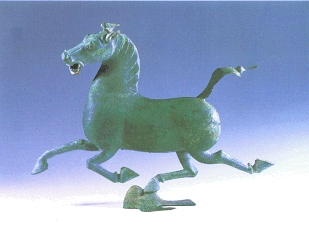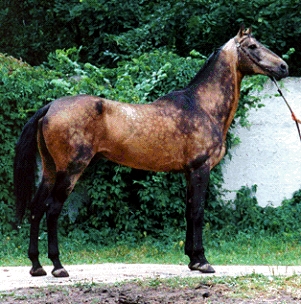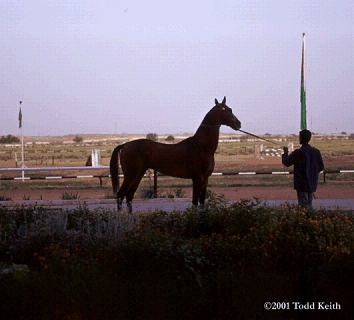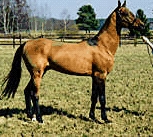Heavenly horse and bird
By Wang Zhenshan and Jessica Eile-Keith
“Falcon is your half-brother; light winged dove is your brother”
from the Turkmen poem Steed by Myataji
1. Horse Stepping on a Flying Swallow
A bronze horse sculpture was unearthed in an Eastern Han Dynasty (25-220 A.D.) tomb in Wuwei County, Gansu Province, in 1969. It is 34.5 cm high and 41 cm long.
The bronze statue, created about 2000 years ago, shows a horse in lively action and accurate of proportions. The horse is raising its head, neighing and galloping forward with one foot stepping on a flying swallow.
The statue was named "Horse Stepping on a Flying Swallow" by the famous poet, historian and archeologist Guo Moruo (1892 - 1978).
According to analysis of its mechanics, Horse Stepping on a Flying Swallow finds a center of gravity in the swallow to give the statue its stability. The romantic image of the swallow sets off the power and strength of the horse, providing a rich imaginative experience for viewers.
The piece depicts a vigorous horse with long tail waving and head perking.
Its three hooves are in the air, galloping like lightening. What makes this sculpture amazing is the right back hoof of this galloping horse lands on the back of a small flying bird.
The bird turns in surprise to look at the big creature on its back. At the same moment, the horse's head also turns slightly in attempt to know what has happened. The whole statue is honored as the mysterious and rare treasure in the history of Chinese ancient sculpture art.

The sculpture of this horse was made after the introduction of the Heavenly Horse to China. The horse in the sculpture displays several traits typical for a mature Teke stallion. He has a long and high carried neck, long back and a narrow torso. The dry and noble head with a slightly hooked nose and large eyes is seen in the Tekes even today. The long slender legs are typical and the Flying horse also moves with the fluid gaits of a Teke. |
The horse in the sculpture is faster than the bird and also closer to the heaven than the bird. The bird being the rulers of the sky, is maybe surprised to find an earthly steed being between him and the heaven.

The stallion Singapore, born in Turkmenistan could be compared to the Flying Horse from ancient times. He is a strong a powerful horse, yet elegant and noble. The neck is long and carried high, the head is dry and sculptured with a slightly convex nose line.
The legs are long and slender and the torso is tubular. |
Still being the fastest horse in Central Asia the Teke has been surrounded by myths and legends about being faster than the bird.
The image of the bird being outrunned by the Teke is repeated with the Turkmen tribes that have protected the purity, speed and nobility of the Heavenly Horse for thousands of years.
2. Unique competition
There is a legend in Turkmenistan.
Once upon a time, there was a slim, golden-bay Akhal-Teke stallion called Akhale and no one horse could beat him during a race.
It was decided to make a competition between the horse and a falcon. Thousands of people gathered from all quarters to witness the unique competition. The owner of the falcon and the bay stallion stood at the top of the hill. The falcon and Akhale started the race at the same moment.
The golden-bay stallion flew like an arrow through the astonished viewers leaving the falcon far behind. Since that time Akhal-Teke stallions are often given bird’s names.
3. Heavenly horse and bird
There are several famous horses in ancient China, the names of those horses are Chen Fu (Morning Wild Duck), Zi Yan Liu (Purple Swallow Bay), Bai He (White Crane) and Fei Hong (Flying Swan Goose).
As we know, Akhal-Teke stallions are often given bird's names such as Melekush (Yellow Bird), Karlavach (Swallow), Karakush (Eagle), Lachyn (Falcon), Durna (Crane) and Burgut (Golden Eagle).
Eventhough there are some differences between the two legends above, the plot is similar. And still today the the golden horses are racing against birds and is called the wings of the Turkmen people.

One of the best examples of the breed of today, Piyada raced and won against a falcon on the Ashgabat Hippodrome in the year 2000. |

Some Akhal-Tekes actually have images of wings over their withers. The stallion Osman has black wings over his withers. |
|